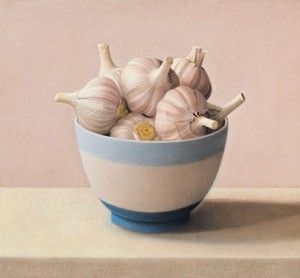A love-hate affair
There’s a curious Jekyll and Hyde personality about garlic.
Old friends of this member of the allum family will not be surprised by this, but newcomers may be caught off guard. Crush a clove or two and add it to a salad – its pungency is unmistakeable.
But cook the cloves slowly with a casseroled chicken and their flavour is transformed into a delicate sweetness.
I once attended a cooking demo at the Aspen Food and Wine Classic in Colorado, U.S.A., given by the Italian cookery author, Marcella Hazan, in which she showed its inconstant nature in a number of dishes. To obtain the most subtle scent of garlic, she pointed out, peel it, taking care not to cut it, fry the whole clove until it becomes a very pale gold colour, then remove it from the pan before adding other ingredients.
To increase its intensity, crush it before peeling it. For a delicate, sweet, but barely perceptible flavour, cut the peeled clove into very thin slices, cook it briefly until it just sizzles, then add the other ingredients.
For a dish requiring a lustier garlic aroma, chop the peeled garlic finely, cook it until it is pale gold, then add the other ingredients.
Raw garlic chopped to a puree is the most powerful of all. Mixed with olive oil, it becomes aioli, the garlic mayonnaise of Provence.Remember that the finer garlic is chopped and the darker it is cooked, the sharper it will taste.
If you overcook it and it becomes brown or black, it will taste acrid – best to toss it out and start again. Marcella is not a fan of crushed garlic as crushing garlic releases its essential oils.When buying garlic, look for fresh tender plump cloves without green shoots.
One of my favourite ways of dealing with garlic is to cook the whole bulb. I take a slice off the top, drizzle the cut cloves with olive oil then wrap it all up in foil and bake it in a moderate oven until the cloves are tender. When it’s cool enough to handle, I squeeze out the soft subtle flesh from each clove (magic!) and can eat it on the spot. Great spread over crostini or bruschetta or to accompany grilled lamb cutlets. It has the consistency of butter and its flavour is sweet and subtle.
We grow a number of different varieties in Australia – the Creole (or Mexican), Itaian and Russian being the major ones. The colder the winter, the stronger the garlic will be. The Creole has larger cloves; the Italian has smaller cloves with a pinkish tinge (and stronger flavour) whilst the Russian Giant (or Elephant garlic) has large individual cloves and is darker in colour.Experts claim the latter is not, however, a true garlic and its flavour is rather bland. You’ll find Thai garlic (katiem) in Asian food stores – it is smaller and sweeter than the Italian and has a purple tinge.
We still have to import a lot of garlic, much of it from China, because we don’t grow enough. It’s often stale, wrinkled and old. Best to avoid old garlic because it can be bitter.
In spring, some farmers’ markets and greengrocers carry fresh young green garlic which looks rather like a baby leek. If you slice it finely and toss it through a salad or pasta, it will add a lovely zing.

